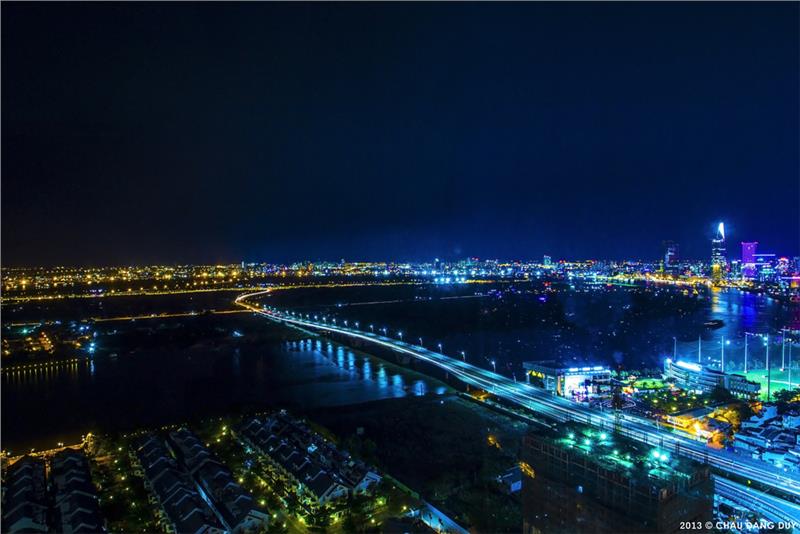Even at first glance, Ho Chi Minh City, also known as Saigon has left a deep impression on foreign tourists as the most
dynamic and hurly-burly urban in Vietnam with gleaming streets, activities and
entertainment lasting till late together with the lines of cars rushing around
the streets like never-ending. Ranges of shops with the great deal of colorful
and varied products contribute to fame "Saigon - shopping paradise".
Numerous bars, stores and restaurants with fascinating menus make the Saigon's
culinary become an indispensable cultural characteristic for tourists. However,
deeply hidden in the excitement is a liberal life but harmonizes, with the longstanding
customs and habits of traditional culture which have adapted to the life for
reclaiming the land and early interfered with the culture of the region and the
Western.
 |
| Ben Thanh Market |
Ho Chi Minh City is the gateway to tourism, a major and
largest tourist center in Vietnam thanks to the varied system of facilities and
services. The climate in the city is fairly pleasant creating the tourist
season year-round and facilitating to much stronger develop Saigon tourism.
Saigon nowadays retains hundreds of pagodas, temples worshiping thousands of
national heroes, the remnants of the liberation of the city and country, which
are respectfully preserved. They are also the alluring tourist attractions in
any Vietnam tour packages to Ho Chi
Minh City. Over 1,000 temples, temples and shrines built over time has been the
wealth property on culture, art and architecture. Tourists will find here the
largest and most beautiful pagodas in the country which skillfully combined
between modern style and traditional pagoda architecture. Owning the diverse
and abundant architecture, numerous pagodas have been recognized as historical
- cultural relics of the city and the country.
 |
| Ho Chi Minh City |
The architecture of Saigon - ancient Pearl of the
Far East has been preserved and embellished, becoming the exciting sights in Ho
Chi Minh City. The French have left a large number of various and wonderful
architectural works. It can be said that there are not numerous metropolises in
Southeast Asia possessing as many architectural forms and Western art style as
in Saigon - Ho Chi Minh City. Typically, the headquarters of Municipal People's
Council built under Third Republic France architecture, State Bank under the
influence of Art Nouveau, Children's House with Neoclassic style, Nha Rong
Wharf under Indochinese style, Central Post Office under Chiet Trung
architecture, Saigon Notre-Dame Basilica with Roman style, Huyen Sy Church
under New Gothic architectural style... Besides, there are numerous
contemporary works inspired from the Vietnam traditional architecture. In the
crowed city, tourists will be surprised with boulevards shaded hundred years
old trees, the greenery parks, and tranquil villas. Beside the new skyscrapers
in the city center, tourists will have the chance to visit Cholon (Chinatown)
with the bustling ancient towns, commercial activity and production bustling
over day and night.
 |
| reunification palace |
As a tourist center and the largest tourism gateway
in the country, Ho Chi Minh City has retained the relatively developed system
of infrastructure and tourist services, from the entertainment centers, transit
systems to museums, hotels and restaurants. Tan Son Nhat International Airport,
one of the primary international airports in Vietnam located in Ho Chi Minh
City is always ready to meet tourists' demands of movement. Vietnam Visa service here is also
extremely convenient facilitating tourists' trips much easier and faster.
Thanks to the diverse museum system, Ho Chi Minh City maintains more museums
than other provinces in the country. The exhibit contents of the museum are
fairly bountiful not only on the local history and culture, but the whole
South, the country and Southeast Asia as well, offering huge interesting knowledge.
However, the most attractive tourist spot in the city remains Cu Chi Tunnels, a
unique works in world military history, a symbol of the iron will and the
intelligence of citizens in American resistance. Equally illustrious is the Can
Gio mangrove forest with ship breaking battles on the Saigon estuary, which
today is a great eco-tourism with the endless green mangroves.
 |
| Gate to post office |
Taking part in HoChi Minh City tour, tourists could hardly escape to be overwhelmed by the
system of the markets, supermarkets and commercial centers of the city. The
abundant, diverse and colorful goods full species from the common to the famous
deli's all over the country, from domestic products to the international brands
globally reputing. Most of stores here often beautifully decorated, especially
the stores of handicraft and fashion, each looks like a tiny work of art. Ben
Thanh Market, a symbol of Saigon, is considered the largest retail market in
the city. Tourists can find all sorts of items here, from budget to luxury,
especially food products which are most selective. The friendly and open-minded
citizens are always looking forward to welcoming tourists from all parts of the
earth to the city.
 |
| Notre Dame Cathedral |
As the center of the fertile lands of the South, the
convergence of people from all over the country and the gateway to external
world, Ho Chi Minh City is one of the most attractive destinations in Vietnam travel. Ho Chi Minh City tourism has played an important role to promote
the image of a beautiful Vietnam country to international friends.




